From D&D to FF7
Final Fantasy 7 is a role-playing game, and so in one sense it is relatively easy to write about it. Role-playing games (hereafter RPGs) are probably more popular now than they have ever been, and that familiarity makes the audience for this book a little larger and a little more familiar with its technical terms. On the other hand, there is a lot of disagreement in the RPG audience about what RPGs should be. If a player’s first experiences with an RPG are in games like Skyrim, The Witcher, or Dragon Age—or older games like Ultima, Wizardry, or Baldur’s Gate—then that player might have certain expectations of an RPG. The games I just mentioned feature lots of non-linear/open-world exploration, branching dialogue, character classes, deep character customization, and the ability to make decisions that meaningfully shape the narrative. Final Fantasy 7, by contrast, is linear, authorial, has no meaningful character classes (with one exception), minimal character customization, and no way to meaningfully change the outcome of the narrative. That’s a pretty profound discrepancy in style, which begs two questions: why do many RPGs have all those features I listed, and why does FF7 lack them? The answer to these questions isn’t as simple as developer preference. It isn’t as simple as saying “well, FF7 came from Japan.” To understand the real reason why FF7 differs from the most popular RPGs of our era, we have to go all the way back to the first RPG, Dungeons & Dragons, and see how its influence caused designers to make a variety of very strange games.
One of the best and most helpful things about the history of RPGs is that it has a clear starting point. The RPG from which all others are descended is Dungeons & Dragons (traditionally called “D&D”, an abbreviation that I will use except at the beginning of a sentence). The history of videogames is not quite so clear; many different developers started creating games at different times and in different places, and videogames didn’t find their unique voice for several years after they became a mass market product. Dungeons & Dragons took shape in just a few years, and then continually expanded. By 1981, the year in which computer RPGs began to appear in significant numbers, D&D included so many game design ideas that it was extremely difficult for other designers to come up with anything new in the genre. Thus, RPG designers used three strategies for creating their own RPGs: simplification, combination and specialization. I’m going to explain what each of those terms mean in the context of RPG history, but I want to point out now that it’s the last of these strategies that FF7 follows. One mistake that I think many critics and players of today make about FF7 is assuming that its developers were trying to make a game like Skyrim, Baldur’s Gate or Ultima and simply failing. That’s an easy mistake to make, because the Final Fantasy series changed a lot between FF1 and FF7. But ultimately, the reason why FF7 lacks things like character classes, customization and open-world gameplay is that it deliberately gives those things up in order to pursue something else.
In the Beginning: The Path to D&D
The RPG genre is built upon three essential design ideas: the simulated skill, level-ups and orthogonal roles. These ideas didn’t spontaneously appear in the RPG, but rather developed in a genre which preceded the RPG—the genre of wargames. The wargame with which most people are familiar is Risk. Risk features all the classic wargame ideas: players control zones on a map with miniature figurines. The figurines represent units in an army, and their strength depends in part on the roll of dice. Although Risk came out of the golden age of wargames, it is a simple example of a complicated genre. Although popular, it isn’t quite as influential as most of the games we’ll examine below. And despite being old by modern game standards, Risk is relatively recent in terms in the context of wargames. The wargame genre goes all the way back to the late 1700s, but the history of the genre first became specifically relevant to RPGs in the 1820s. The game in question is called Kriegsspiel, and it was the long term project of a father-and-son team of Prussian aristocrats[1][2]. Their goal was to improve the on-field tactical skills of Prussian army officers. Whether or not they succeeded is a matter for military historians, but their game is definitely the source of some important game design ideas. Kriegsspiel pits two military commanders against one another using small tokens that symbolize units within an army. The strength of those units depends heavily on the rolling of dice and factors like unit health, firing distance, differences in elevation, etc. A neutral umpire interprets the dice and other factors and tells the two combatants the result of their attempted actions[3]. Players of tabletop RPGs will immediately recognize what the neutral umpire eventually became: the dungeon master (DM), a role which is tremendously important in the tabletop RPG.

 [4]
[4]
The most important thing to recognize here is not the just the first documented existence of something like a DM, or the use dice to govern combat, but rather what they combine to accomplish. Taken all together, those things give us the simulated skill. A simulated skill is any skill which belongs entirely to a character in a game, rather than to the player who controls the character. In Kriegsspiel, the player doesn’t have to do anything to attack except to declare to the umpire their intention, and then roll the dice.[5][6] The dice roll (simulating randomness) plus the umpire’s interpretation of the circumstances of the attack (simulating battlefield conditions) account for all the execution.[7] Compare this to a game like basketball or Super Mario Bros—in those games the player has to use manual dexterity and precise timing in order to perform crucial game functions. In a game like Kriegsspiel (or FF7 for that matter), all the dexterity, strength and timing are simulated by numbers and rules. In RPGs, those stats are explicitly labeled “strength” or “dexterity.” Wargames didn’t really have that level of granularity until Gary Gygax and Jeff Perren came along, but Kriegsspiel still codified this idea by basing the strength of any given military unit on the current population of that unit.[8] In other words, the HP determines the damage. The execution is rudimentary, but it’s still the same design idea upon which RPG skills depend to this day.
It would be almost 150 years before the other two pillars of the RPG evolved. The 1960s were the golden age of tabletop wargames, with their popularity growing markedly thanks to the formation of regional clubs, the publication of enthusiast periodicals, and the establishment of an annual conference where wargamers would gather to play.[9][4] The two creators of the RPG, Dave Arneson and Gary Gygax, were both avid players (as well as designers) of the genre, and they met for the first time at one of these conferences. The date was August 23, 1969 and the location was Horticultural Hall in Lake Geneva, Wisconsin, which the International Federation of Wargaming (of which Gygax was an officer) had rented out.[10] This conference was called the Geneva Convention—or GenCon for short—and tabletop gaming enthusiasts have attended it annually for nearly 50 years since that time. Dave Arneson was an undergraduate student studying history at the University of Minnesota and a central figure in a group of wargamers from the Twin Cities region. Gygax was older, a father of several children, and employed full-time as an insurance underwriter in Chicago.[11] Both of them were working on experimental wargames at the time, and it was the combination of these two experimental projects which would lead to the creation of D&D.
Gygax’s most important game prior to D&D was Chainmail, a game he had been developing with his colleague Jeff Perren.[12] This game refined simulated skills and (almost accidentally) created the first character-level mechanic. Chainmail is a game which allows players to simulate the command of a relatively small number of medieval combatants. Although not especially original, Chainmail’s rules are fairly easy and enjoyable to use, and allowed for low-population medieval combat.[13] (It was probably this last quality which motivated Arneson to borrow some of these rules for his own games—wargames of the 1960s tended to be enormous and enormously complicated) The core Chainmail rules are historically important; many of the rules and concepts that first appeared in Chainmail would later appear as mechanics in D&D.[14] As I said earlier, however, these rules aren’t historically novel; dozens of wargames had similar mechanics—it’s just that Chainmail’s ruleset was elegant and easy to use. The real innovation in Chainmail is in its appendix, the “Fantasy Supplement.”

 [15][16]
[15][16]
In the fantasy supplement, Gygax allowed players to use hero units which were significantly more powerful than their rank-and-file counterparts. Of course, these units had to obey the overall balance rules of the genre. In a typical wargame, each general is given a budget of points (e.g. 500 points) to allocate to different parts of his or her army. Footmen cost very little, perhaps 1-5 points to deploy. A heavily armed tower might cost 40 or more points to deploy because of its greater power.[17] The heroic units of Chainmail’s fantasy supplement can cost more than 50 points to deploy because of their many tactical abilities. The really interesting thing is that the cost of a heroic unit can be scaled by “level.” A wizard costs 100 points to deploy and has a large suite of skills like “Fireball” and “Magic Mist.” The general can also deploy a lower-level hero, like a sorcerer—which Gygax calls a wizard minus 2.[18] The sorcerer, although still much more powerful than a regular unit, is less powerful than a Wizard, but only costs 80 points to deploy.[19] In Chainmail, the point of reducing a hero’s level is to reduce that hero’s deployment cost, but hero level would soon serve a very different purpose when Dave Arneson got a hold of it.
Arneson’s pet project at the time he met Gygax was called Braunstein, in which he developed the concept of orthogonal roles. Braunstein wasn’t Arneson’s original creation—that credit goes to David Wesely—but Arneson had continued development when the game’s creator departed for military service.[20] Braunstein is notable for its introduction of orthogonal player roles. Up until this point, the players of a wargame generally occupied the same roles and had very similar victory conditions. Sometimes the starting conditions or victory conditions were slightly asymmetrical—but in almost every game, the player assumed the role of a military commander trying to pull off a narrow range military victories.[21] In Braunstein, two military commanders face off against one another, but there are also non-combatant player roles, like the chancellor of the university in the fictional town of Braunstein, or the leader of the student union there. These roles are very different from the two generals; they have their own motivations, their own goals, and a non-military set of abilities. [22] The presence of non-military characters has an impact on the tactical considerations of the battlefield, but the more important (and less obvious) change brought on by non-military roles is the ascendancy of playing a role in-character. The two military commanders in Braunstein, like the military commanders in any game, are driven by practical battlefield concerns. The orthogonal characters, like the student and the chancellor, are driven by their personal (narrative-driven) imperatives which are more dramatic than practical. The players who act as student, chancellor and so on are all playing roles like actors might play them, but with significant game elements added to the drama.
Arneson combined the simulated skills of the traditional wargame, the orthogonal roles of Braunstein, and the proto-level mechanics of Chainmail to create the first game that could be called an RPG. The product of these ingredients was called Blackmoor. Blackmoor put these ideas to work in a format in which hero units could appear serially in a variety of qualitatively different adventures.[23] To make this possible, Arneson had to tweak each of the design ideas he inherited. The simple simulated skills of the wargame were not nearly granular enough to work for the variety of adventures that he had in mind. Using the same skill to swing swords, cast magic and pick locks would be silly, and so Arneson and his group of fellow gamers created individual specialty skills like “strength,” “courage” and “brains.”[24] The neutral umpire role which was common to wargames wasn’t sufficient for a linear format with more than two players. The umpire had to also play the role of author, nemesis and referee, and thus the role of dungeon master was born. Orthogonal roles were translated directly and easily when they were combined with the different classes of hero from Gygax’s Fantasy Supplement to allow players to play Warriors and Wizards. The defining idea, however, was the adaptation of hero levels. Instead of scaling a hero’s level downwards to reduce his deployment cost, Blackmoor allows heroes to gain levels as they complete various activities.[25] This is a double simulation of skills, for a hero’s level is both involved in calculating his current power and in tracking the ongoing acquisition of more power. This ongoing growth of character abilities is the glue which holds the serial quests of an RPG together and separates the genre from its wargame forebears.
The Titan in The Sand: The Overwhelming Legacy of D&D
The most famous product of Arneson and Gygax’s experiments in game design is D&D, a game whose popularity has endured to this day. Although Arneson first put the form of the RPG together in Blackmoor, Gygax was quick to recognize its potential, and he massively expanded the game throughout the 1970s.[26][27][28] The company whose imprint D&D bore, Tactical Studies Rules, began to grow just as rapidly.[29] But what was really remarkable about D&D was that it received so much development so quickly. In the late 1970s, the books which constituted Advanced Dungeons & Dragons (AD&D) came out, each of them rich in game design ideas. Below is a list of just some of the ideas found in those publications, which hopefully conveys the amount of development the RPG endured in those early years.
 [30][31][32]
[30][31][32]
This list could easily be double or triple its current length, but that much documentation lies outside the purview of this book. The list is massive, however, and it only got longer as TSR released new material. There are two reasons why I show the list above. The first reason is that it can be astonishing to see how rapidly the designers of early RPGs created nearly all the mechanics which now define the genre. But, then again, it shouldn’t be astonishing. RPGs didn’t come out of nowhere; they came out of an extremely rich tradition of wargames that stretched back more than a century. The point of that genre had always been to painstakingly simulate real historical battles, and numerous wargames had done just that, in different ways. Dungeons & Dragons operates by the same idea, but instead of historical battlefields, it simulates a Tolkienesque fantasy world. The speed at which the tabletop market pivoted from wargames to RPGs is remarkable, but it wasn’t a fluke. This will be important later when we look at how—in the space of 10 years—Final Fantasy completely changed direction artistically and did something radical with the RPG. The second reason why I show this list is that it should be clear that by the time RPGs began to proliferate on computers and home consoles, they had already benefited from incredibly robust and wideranging rulesets. So vast were these rulesets that no digital form could ever implement them all. (This is still true. No computer yet invented can hope to replicate the fecundity and flexibility of human imagination, but the restrictions in 1980 were even more limiting.) That limitation would cause RPG developers to employ three innovative strategies for creating their own distinct games.
The Necessary Simplification
With limited manpower and even more limited computer resources to draw upon, the early digital RPGs were mostly versions of D&D, or what I call simplifications. Games in the simplifications category simplify the D&D source material in order to make something like D&D possible on a computer—although they’re not necessarily trying to recreate D&D.

The first Ultima game (1981) is a good example of this phenomenon. Clocking in at about five to ten hours, Ultima features most of the basic D&D design ideas, although it can’t implement the massive freedom allowed by imaginative humans around a table. Moreover, although Ultima does the things D&D does, it rarely does them in quite the same way.[33] The level-up system and design of dungeons in the original Ultima are handled quite differently than their counterparts in mainline D&D Campaigns. But with one exception—a poorly integrated and brief shooter section—Ultima only does things which were already hallmarks of D&D. This is the nature of simplifications; games of this type inherit the scope of D&D, but not all its methods. Changing the methods changes the feel of the game significantly, but it doesn’t constitute an original invention. Other games which fall into this category are Wizardry (1980), The Bard’s Tale (1985), Might and Magic (1986) and Baldur’s Gate (1998)—or many of the sequels in those series. Each successive game in those series moved closer to the kind of scope a great D&D campaign would have, because that was always the ultimate goal of the simplification strategy. I’m sure that some tabletop enthusiasts have noticed that I haven’t mentioned any of the other major pen-and-paper RPGs that influenced videogame designers, like Runequest, Traveler or GURPS. In my view, none of those games expand the scope of the RPG form in a way that D&D did not do first. Indeed, most of the D&D editions to come out after 1989 didn’t expand the scope either, although they and their competitors still have plenty of value. Starting with AD&D, one of the most important tasks for designers at TSR was to revise the massive array of game design ideas which came from Gygax, who produced great concepts but often used bizarre implementations. The efforts of Gygax’s successors were crucial, because execution is at least as important—or perhaps more important— as the concepts they execute. Mediocre concepts can make for fun games when implemented particularly well; great concepts implemented poorly rarely succeed.
RPG Plus X
Simplification is the easiest strategy to identify, because it followed D&D so immediately and in such a clear way. Simplification is not, however, the most popular strategy for escaping the encircling influence of D&D. The most popular strategy is combination. Combination is simply the practice of combining RPGs with another genre. The practice of combining two genres in a videogame is a very historically important one that led to an entire school of game design. (You can read much more about this history in the Reverse Designs of Super Mario World and Half-Life.) Role-playing games are no exception to this trend. The most famous product of the union of native-videogame genres with RPG design ideas is the action-RPG. One of the big successes of the action RPG is the inroads it made into the console market.


Although action RPGs employ many RPG ideas which first appeared in traditional RPGs, they also feature a huge variety of fresh action game ideas. Indeed, the proliferation of action game ideas throughout the 1980s and 1990s ensured that action RPG designers never had to worry about being different from D&D. Action game tropes, injected into an RPG mold, made for games that seemed fresh and distinct. Certainly, real-time (or at least limited-time) play was a house rule in plenty of otherwise traditional D&D campaigns, but none of those games could have offered the kind of dexterity/speed challenges that a console game could.
The action RPG was one of the first fruits of the marriage of RPGs and extant videogame genres, but it is hardly the only one; RPG ideas have infiltrated all manner of games. For example, the FPS/RPG hybrid is a fairly old one, but it has come to spectacular prominence since 2007.

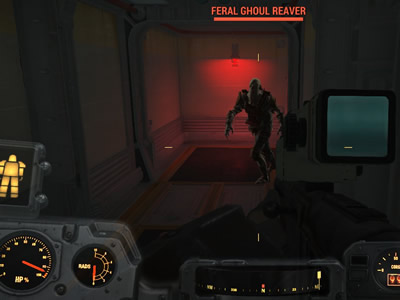
The combinations are apparently endless, and sometimes quite surprising. ActRaiser combines a somewhat standard action RPG with a city-building overworld game. This is a combination which would eventually also appear (although in a very different style) in Minecraft.

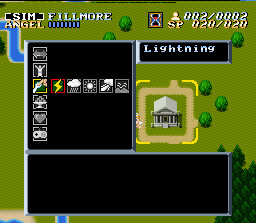
Although RPG elements are nearly ubiquitous in contemporary game design, not every genre uses them liberally. The one genre (aside from RPGs themselves) which uses lots of RPG elements (and uses them well) is the tower defense genre. Although there isn’t enough space to cover them all in this book, two great examples are Gemcraft and Defender’s Quest, which execute incredibly deep RPG mechanics in a tower defense framework.
A Small Slice of a Genre
Designers who did not want to combine their RPG with something else, and did not attempt to recreate the whole of D&D employed the last strategy, which I call specialization. If D&D was too massive to recreate, but too artistically complete to avoid entirely, designers had one other option: pick a part of the D&D formula and embellish it. The best way to explain this is by using an early example. The 1980 game Rogue uses all of the essential RPG mechanics that were codified in D&D, but it focuses entirely on dungeon exploration. There is no plot. There are minimal NPCs (shopkeepers travelling through the dungeon at random) but there are no towns, no charisma checks—there is only dungeon-crawling. By stripping away everything that isn’t a dungeon, Rogue is able to get players in and out of combat very quickly. Whereas dying in a typical D&D campaign can slow the game down as players pursue ways of replacing or resurrecting their party members, Rogue doesn’t even allow for any of that. After death, the player is immediately back in a dungeon, fighting, disarming traps and looting treasure. Simplification-type games drop parts of the D&D scope because they can’t fit them in—it’s a practical decision. Specialization-type games, on the other hand, drop parts of the D&D scope in order to deliberately reduce scope and embellish a smaller set of design ideas—it’s an artistic decision.
An entire subgenre sprang from what Rogue did first. The roguelike genre, although it has changed over the years, is more popular now than ever before. Nethack, Diablo, FTL and The Binding of Isaac are just a few of the most well-known titles in that burgeoning subgenre. Final Fantasies 6 and 7 are some of the first non-roguelike games which employed the strategy of specialization to great success. Both games would focus primarily on the storytelling and/or world-building aspects of the RPG: rich characterization, fantastic but persuasive settings, and thoughtful, meaningful quests. One of the really interesting things about this change is that it happened to a series that started as a simplification. Another interesting turn is that at the same point where the Final Fantasy series was entering its most idiosyncratic form, other RPGs started to appear that employed the same strategy in different ways. We’ll reflect on that after we see how Final Fantasy went from simplification to specialization across its first seven titles.
Final Fantasy as a Series of Increasingly Interesting Protagonists
One of the widespread features of a simplification-type game is a blank or minimalist protagonist. This is an unimpressive fact for me to unveil, but I think that the bland protagonist is actually a great barometer for the type of RPG a given game wants to be. In a D&D campaign, the protagonist is a fluid expression of the player’s imagination and can make whatever choices the player and DM agree are possible. This freedom of action and characterization were the first casualties of the transition from tabletop to digital formats. No computer can hope to recreate the human imagination, and so no player-character can embody the choices and personality traits that its player would enjoy in a tabletop setting. The simplified design idea which many games still use in place of a fully-acted character is a minimalist protagonist who primarily makes choices.
 [35]
[35]
The heroes of Ultima and Wizardry have essentially nothing in the way of defined personality. There are plenty of decisions for the protagonist/ player to make, but most of them have to do with practical problems: which query will get the innkeeper to dispense a quest? Which query will get secret information out of the roadside traveler? Do I kill this creature or spare its life? These decisions tend to be performed as shrewd calculations rather than as expressions of an imaginary person with consistent traits and a dramatic arc. This doesn’t mean that these games lack characterization entirely. The later Ultima games are famous for the depth and complex interactivity of their NPCs. But the simplification style did force RPG designers to treat their protagonists in a reductive way to preserve some sense of the original tabletop freedom. The Final Fantasy series features bland and/or blank protagonists for its first five games as well. Retrospectively, FF titles are well known for the variety of vibrant and memorable characters they have—and that was true as far back as FF4—but the protagonists of those early FF games were thin. In the first three games, they were effectively silent except for quest-based keywords. It wasn’t until FF4 and FF5 that protagonists started to have real dialogue, and even then they didn’t have anything particularly personal to say.


Cecil and Bartz/Butz have feelings distinct from the players that control them. Yet, most of what they say and feel is unfailingly (and blandly) heroic. Cecil and Bartz mostly want and feel things that will push the quest forward. Moreover, these two designated protagonists are the least interesting members of their respective parties from a characterization standpoint. Really, all of the early FF protagonists are necessary and unsurprising, because the first five titles in the Final Fantasy series fall into the simplification type of RPG. Yes, there are some important divergences in these games from the D&D source materials. Final Fantasy titles (like most Japanese RPGs) allow the player to gain vastly more levels in a single campaign than a Western RPG does, although each level was less meaningful to balance those gains. Also like many other Japanese RPGs, critical hits and critical failures are a much less important part of the game. But job classes and party composition are still paramount, and protagonists are still mostly-blank canvasses onto which the player can project their own ideas.
The first really radical FF title is FF6. Critics have long held that FF4 was where the series started to distinguish itself and become the series that we know today. In terms of plots, settings and art concepts, I think that might be true. The journey that FF4 takes the player on is pretty wild, and includes an accelerated-time pocket dimension, the hollow underside of an entire world and a trip to the moon. More importantly in FF4, a ton of characters move in and out of the party, which would end up being a very Final Fantasy thing to do. The thing that prevents FF4 from being radical is party composition. Every character in FF4 has a job class with strengths and weaknesses. Party composition and character roles are an important tactical part of the game, but with all those characters coming and going, the party is kind of a mess until it stabilizes (in a totally orthodox confi guration) late in the game. Party composition alone makes some dungeons and bosses inappropriately hard or easy for the point of the game in which they appear. Final Fantasy 6 is able to maintain a large roster of characters without any practical problems by diminishing the importance of character classes. There are 14 characters to play in FF6, and any four of them are totally viable as a main party. The two lower-level design ideas which make this possible are greatly revised magic mechanics and the availability of powerful armor for any class. Because of the way the magic damage formula works in FF6, any character can be turned into a serviceable mage—in addition to being an engineer, samurai, or monk.

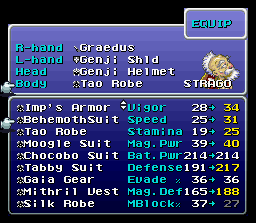
What’s more, the characters who are mages can equip allegedly “light” armor which is statistically equal to or even better than some of the best “heavy” armor in the game. This abandonment of the tactical differences between character classes is the fi rst real move by Final Fantasy towards becoming a specialization-type game instead of a traditional simplification.
The diminution of character classes is a profound artistic decision and a huge departure from the RPG heritage, but it allows the Final Fantasy games of the mid-and late-1990s to do something artistically bold. More than 150 years of tactical heritage were cut out of FF6 in a single decision, but look what it allows the game to do: FF6 has no clear protagonist. One can argue Terra is the “main” character, but she’s far from being the most talkative character in the game.
 [36]
[36]
Terra is very important to FF6, but the plot of the second half does not revolve around her. Indeed, it’s possible to beat the game without her. This is because when the World of Ruin begins, Terra is off on her own deeply personal quest.

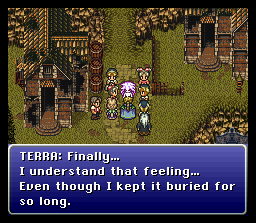
Irrespective of the player’s wishes, Terra finds her own meaning by becoming the guardian of the Mobliz orphans. Terra wants to love and be loved by a group of minor characters the player may not care much about. Even if she is the protagonist, her struggle is not just the bland, uniform destiny of a world-saving hero; it’s much more human in scale and idiosyncratic in nature. The same is true for most of the characters of FF6—they all find personal reasons to continue their fi ght against a world that seems hopeless.


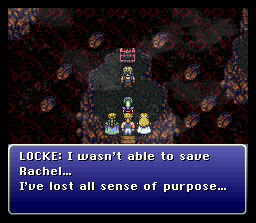
The player isn’t given the traditional RPG freedoms, choices and tactical puzzles to solve, but in place of those things, the player gets to explore a thoughtfully-imagined world with a group of people they can really care about. That’s exactly the kind of artistic trade-off that typifies a specialization-type game.
All of the trends that make FF6 a radical game exist in FF7 to an even greater degree. The diminution of character classes is the most obvious trend. In FF6, characters have classes, but the differences between those classes are less important than in other RPGs. In FF7, there is only one character that has a clear job class: Aeris. Aeris is obviously a mage; she is the only character that starts in the back row. She has significantly lower attack and defense stats, but compensates for these with well-above-average magic stats. Other characters have slight strengths and weaknesses, but none of them have defined roles. Except for Aeris, everyone is a jack-of-all-trades. Accordingly, it’s even easier for the player to put the party together for plot-and-character reasons. Every party member has unique dialogue for almost every scene in the game, and that dialogue is always written in-character. So if FF7 is dropping one part of the RPG formula to embellish another in the manner of a specialization, it seems that the designers are still interested (as they were in FF6) in embellishing characterization and storytelling at the expense of tactical composition. To be fair, all RPG designers want their players to care about the characters in their games, but in FF7 that “care” means something different. Tabletop players care about their own characters because those characters are the projections of their own imaginations. They care about the other party members because those party members are the creations of their real-life friends, and/or because those party members are tactically necessary. Players care about the characters in FF7 because they are compellingly written.
If any of the above sounds like an attempt to persuade you to like FF7, let me clarify that it is not. As I said in the introduction, the purpose of this book is not to debate personal preferences, but rather to show that people who like FF7 and people who don’t have both missed seeing FF7 for all that it is. One thing I think many people have missed about the game is the almost absurdly radical way it characterizes its protagonist. Final Fantasy 6 had shown that the console RPG audience was perfectly willing to exchange the customizable protagonist and character classes of traditional RPGs for well-drawn, sympathetic characters and a compelling plot. In FF7, the designers take things further. Like the many characters of FF6, Cloud Strife is not a mostly-blank canvas but fully-realized character with his own feelings, mannerisms and opinions. When he’s not thinking about Sephiroth, he has a certain laid-back folksiness to him.
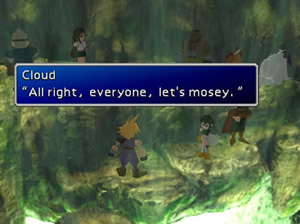

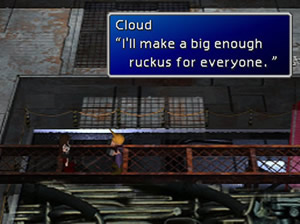
This is a pretty far cry from the typical card-carrying hero that occupies other RPGs from this era. Most of the player-characters in FF7 are drawn with the same level of care, but Cloud is the protagonist and he has a special extra flourish. He is also an unreliable narrator, which is common enough in other forms of narrative, but rare in videogames.
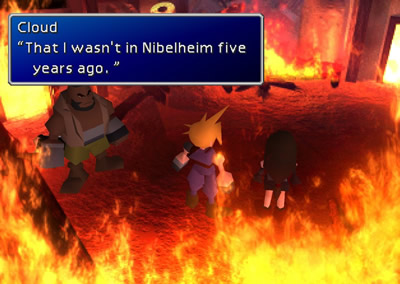
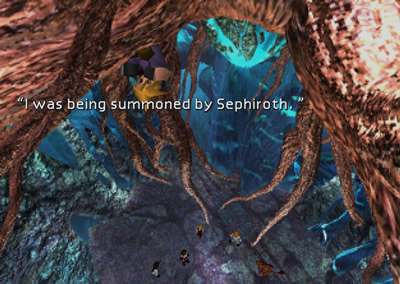
The original Western audience of FF7 also grew up in the era of Fight Club, American Psycho and Memento—popular movies which feature various kinds of unreliable narrators. None of those films offer the kind of connection to their protagonists that FF7 does, however. I don’t mean that the protagonists of those films aren’t well drawn, but rather that the player of FF7 has to rely on Cloud in a way that the viewer of a film does not. When the player wants to explore a town or dungeon, they use Cloud’s body to do it. When they want to talk to an NPC, Cloud is their representative. If he falls in battle, the party is in serious trouble. It doesn’t matter that he’s not a typical vessel for player projections—there’s still a strong association between the player and Cloud. That association is idiosyncratic feature of both videogames and RPGs in general. So when the player finds out that the character they rely on for all of these functions isn’t actually who he says he is, it is a deeply unnerving moment. It’s almost as if the player’s arm has been lying to him or her. Not every player is going to appreciate the effect, obviously, but that doesn’t make it any less radical. Amnesia and deceit are common enough tropes in RPGs, but as far as I have been able to tell, no RPG has ever deliberately betrayed the connection between protagonist and player like FF7 does. It’s a bold, subversive artistic maneuver that—like it or not—sets FF7 apart.
The Age of Specializations
Before moving on to the next section, I want to take a very brief look at FF7’s historical context from a few other perspectives. At the same time that FF7 was eliminating character classes and tactical party composition to make room for more plot and characterization, a different Japanese RPG was doing almost the exact opposite. The original Pokémon titles (1996) are essentially entirely about character classes and party composition. To that end, the game diminishes almost all the other parts of the RPG form. The expurgation is incredibly thorough:
- There is very little plot
- There are relatively few NPCs
- There is almost no characterization of anyone whatsoever
- There is very little non-linear exploration
- There are no choices except choosing between Pokemon
- There is almost nothing to do except fight
All those hundreds of Pokémon constitute an extremely elaborate job-class system. The choice between Staryu and Kingler is a much finer one than the choice between warrior and rogue (or even warrior and paladin), but the type of choice is the same. Pokémon is a specialization that hardly bothers with anything except building the perfect team composition. Whether or not they actually enjoy playing the games, most critics recognize that Pokémon is one of the most brilliant RPGs of all time. What’s strange is that nobody has ever faulted Pokémon for being different from traditional Western RPGs. In fact, very few people even identify Pokémon as being a part of the nebulous “JRPG” category. Pokémon and FF7 are the results of the same artistic strategy—specialization. In their own contexts, they’re both well executed (the rest of this book will argue the case for FF7’s execution). But I think that the best thing we can do, as critics and fans, is to accept that some games can be artistically successful even if we don’t like them. Final Fantasy 7 doesn’t fail to be a big, open, Western RPG; it was never trying to be like that in the first place.
The other perspective we can use to examine FF7 (and Pokémon for that matter) is seeing if the changes they make to the RPG have any basis in the RPG tradition and become something else entirely. That is, does FF7’s intense specialization strip away the essence of the RPG? This is where the history is really useful, because we know exactly how the RPG came about. If you look at RPGs as an extension of wargames, then you could say that FF7 is no longer a part of that continuum. By eliminating essentially all of the RPG’s tactical heritage, FF7 stops being an RPG and becomes something else—an adventure game or an interactive movie that dabbles in RPG stats. And yet, wargames existed for more than 150 years before RPGs emerged. Then, almost as though a switch had flipped, RPGs exploded in popularity and displaced wargames in the tabletop space. This could not have happened if it weren’t for the third and final pillar of RPG design: orthogonal roles. The simulated skills that came from wargames are the bones of the RPG—they give the genre structure. But the heart and soul of the RPG, that which makes the genre truly distinct, is the characters that populate it. These characters came about through the use of assigned, orthogonal roles. Party members, villains and other assorted NPCs are what make RPG worlds persuasive. In an interview he did late in his life, Gary Gygax spoke about his distaste for the kind of quest,
[T]hat has little more in it than seek and destroy missions, vacuous effort where the participants fight and kill some monster so as to gain more power and thus be able to look for yet more potent opponents in a spiral that leads nowhere save eventual boredom. So pure hack and slash play is anathema to me too. [37]
I think this quote shows that the creation of persuasive worlds and characters was always at the center of the RPG. Final Fantasy 7 is, therefore, true to the essence of RPGs, even if its style is deeply divisive.
Introduction - Back | Next - Narrative & Design